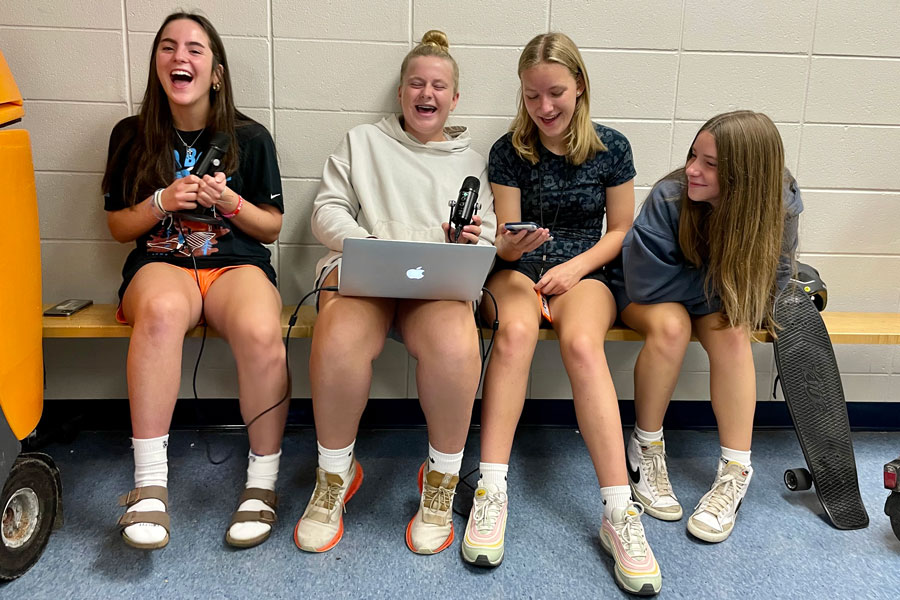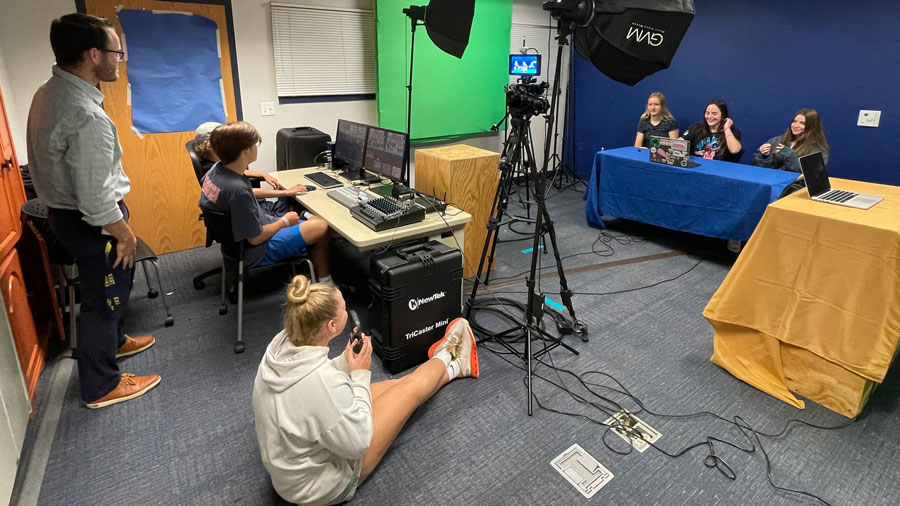East Grand Rapids — With one hand on the switchboard in front of him and one eye on the computer monitors above it, eighth-grader Matt DeBoer watched intently as the cameras rolled. On the other side of the room, three of his classmates sat at a table, facing Matt and the cameras and reading from a script. He waited for one of them to finish the weather report before raising a hand to pause filming.
“Hey, Meredith,” he said, “you went from, like, a little enthusiasm to, like, no enthusiasm at the end. So, like, you should probably try it again.”
Matt was working as part of the production team that week for the East Grand Rapids Middle School’s eighth-grade broadcasting class. The young broadcasters put together a short newscast that the entire school watches on Fridays.
As part of the production team, Matt played a crucial role in many of the “behind the scenes” details that the casual viewer might not notice — like making sure his classmates’ delivery on-camera goes smoothly and with appropriate enthusiasm.
“We’re kind of watching for any minor mistakes that might make (the broadcast) worse, so that we can ask them to maybe tweak it and make it better,” he said. “Like if they’re fiddling with their (microphone), if I have my headphones on, I will catch that.
“We also get all the green-screen effects set up and things like the graphics. It’s basically us behind the camera, behind the scenes, making everything go.”

New Course, New Gear
Broadcasting class is an elective at the middle school, and one that has proven to be quite popular — so much so, that this year they’ve introduced another elective for seventh-graders that is focused on technical and video skills.
This year, students also have the added benefit of using brand-new equipment, thanks to a grant from the East Grand Rapids Schools Foundation. The broadcast studio offers a switchboard that has the option of loading different camera feeds, a two-camera setup, a green screen and more.
“The new system is basically a smaller version of what the high school has, but it’s like a scaled-down version of what actual live TV networks use,” said teacher Derek Dean. “So the students get to learn the software, how to load different videos, how to polish everything up — it looks nicer when it’s polished. And it’s all legit like how the network stations are set up.”
Dean’s eighth-grade broadcasters rotate roles and responsibilities throughout the trimester, to make sure that everyone gets experience with all aspects of the broadcast. Some students will be on camera and some on the production crew, while others work as field reporters to build their interviewing skills. Still others take on the roles of video or graphics editors for the show.
In addition to creating a weekly newscast, broadcasting students also have special projects to work on, including creating a podcast and making a commercial or public service announcement. These assignments give the students an opportunity to keep learning the equipment as they work in other media or for different audiences.
“It’s fun to watch the progression as they build their skills,” Dean said. “The first time they make and edit a video, it takes forever, and then by the end of the trimester, they can finish it in a day. Or the first time they use the TriCaster (switchboard), they’re confused out of their mind, but then after just a few days, they’re doing things with no problem. It’s so cool to see that development as they get more proficient.”

Scaling the Learning Curve
As Matt was directing the weathercast in the studio, classmates Genevieve Kam, Natalie Chappus and Amelia McIntyre were hunched over a computer in the main classroom, reviewing video footage they’d taken earlier. The three were working as field reporters for that week’s show, and they were trying to edit a segment about stereotypes in the style of Dude Perfect, a comedy group popular on YouTube.
“Maybe we shouldn’t have her come in at the start,” Genevieve said as they rewound a segment of video to watch again. “We can cut it around here —” she gestured at the screen — “or maybe when she starts speaking? What do you think?” A spirited discussion ensued.
For Natalie, who had never edited video before, the class came with a big learning curve. But she enjoyed coming up with ideas for the special segments, writing the scripts and filming the interviews. As a whole, she said, the class was getting much better at the broadcasting process.
“Since every week we switch jobs, I like that you can have a new perspective on what you have to do,” she said. “Last year it was really cool to see all the kids doing the show, and I thought it looked like fun and I wanted to take the class. I really like being in videos and learning all the things that you have to learn.”











